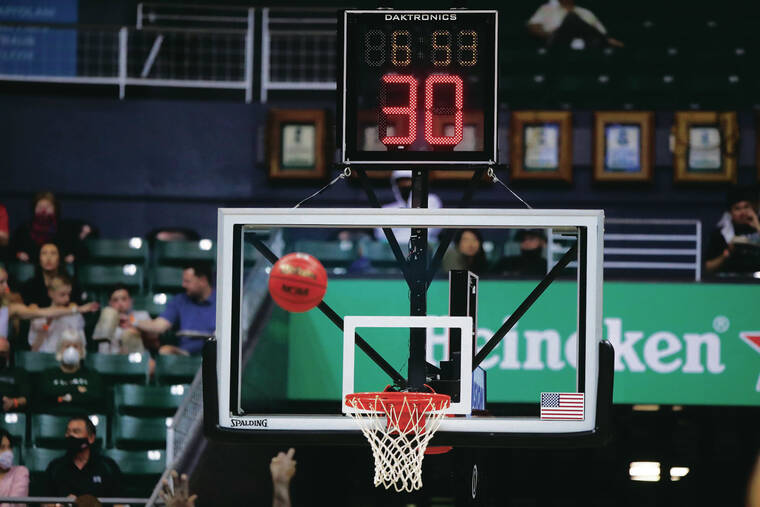
Mahalo for supporting Honolulu Star-Advertiser. Enjoy this free story!
At the beginning, Greydon Espinda wanted something different for his youth league.
When the Compete and Learn basketball league tipped off in 2010, games were at McKinley Student Council Gym, a pristine facility often used for OIA championships. Espinda decided to use a 30-second shot clock for his older age-group divisions, believed to be a first for youth sports on Oahu. Twelve years later, the league is running strong, and so are its shot clocks, all the way down to the fourth-grade division.
“I wanted something different than what the other leagues were running. We chose 30 seconds for a few reasons. College at the time was 35 seconds. NBA is 24, so we took something in between,” said Espinda, who later became boys basketball coach at Kaimuki.
The youngest division, fourth grade, didn’t have a shot clock at first.
“We decided to make all grade levels use the shot clock so all the teams could experience what it was like. A big reason to have the shot clock was to not always have the same player, the best player, always taking the last-second shot at the end of each quarter,” Espinda said.
Last year, the National Federation of High Schools approved use of a 35-second shot clock, with official implementation to begin with the 2022-23 season.
The passage is not a mandate, however. The NFHS is leaving the decision to each state. Eight states currently use a shot clock. Coaches are responding to the possibility. Girls basketball, in particular, is all over the spectrum when it comes to pace and tempo. So we posed a question to girls hoops coaches.
Question: “Should Hawaii implement a shot clock in girls basketball?”
>> Pua Straight, Kamehameha: “One million percent, yes!”
>> Iolani Kaniho, Lahainaluna: “Definitely a yes. I think that should’ve been instituted a while ago. I just think it makes the game flow better and it’s more enjoyable to watch and play.”
>> Shane Lino, Kapolei: “Yes.”
>> Alika Smith, Waiakea: “Yes, because it’s real basketball. We try to get kids ready for the next level. Holding the ball doesn’t get them ready.”
>> Latoya Wily, Kahuku: “Absolutely, yes. This is something I have always wanted for high school basketball in Hawaii, even as a high school student-athlete back in the early 2000s. The transition would be just be a standardized part of the sport on all levels. The shot clock allows for a better flow of the game, eliminates long stalls and I think that it will make it more competitive, rewarding and more exciting not only for the student-athletes and coaches, but also for the spectators watching the games.”
>> Gary Pacarro, Punahou: “Yes, if it was affordable for all leagues in the state to have them, but we know that’s not the case. If our student-athletes, men and women, intend to play at the next level, it’s what they’ll have to work with.”
>> Mark Arquero, Damien: “If money wasn’t an issue, yes. I know it would be difficult for every school to work out the logistics of equipment and staffing to run the additional clock, but in a perfect situation, I would say yes to shot clock.”
>> Vic Aguirre, Maui: “If our girls need to compete with the mainland, then yes. It would help our girls get used to how the game is played in college and some parts of the mainland. Locally, it keeps the game going and doesn’t allow teams to waste the clock, which I’ve seen a lot of. Also, more parity. Since teams that don’t have the talent to keep the ball away with passing and ballhandling can still get opportunities to stay in the game by being rewarded for playing defense for 30 seconds at a time.”
>> Chico Furtado, Maryknoll (girls basketball coordinator): “Yes. That’s how the game has evolved. Every level has it. It leads to a more exciting and intriguing game. Thirty-five or 30 seconds is more than enough time to get a good shot attempt. Any time more than that is just teams electing to hold the ball for one reason or another. Also, it prepares players for the next level, where the shot clock is used. It’s a no-brainer.”
>> Cliff Kawaha, Hilo: “Yes. It makes the kids play more. I think the coaches are taking too much time from the kids, running a lot of plays, which takes away from the kids’ talents and basketball knowledge. With a shot clock, that puts pressure on the kids to use a lot of their basketball knowledge and it also helps prepare the kids who are planning to play in college, where there is a shot clock already.”
>> Reid Sagawa, Mid-Pacific: “Shot clock, yes. We played in an HBA tournament a few years back, including a game with Menlo (Calif.). I felt the shot clock forced us to play with better tempo. You’re forced to move the ball quickly and take the first available good shot. We seemed to have better offensive rhythm during those three games with the clock, and players not overthinking. Also, with more local girls having opportunities in college, not having a shot clock here would not be helping them.”
>> Elroy Dumlao, Leilehua: “Yes. Quick play, everybody got to play almost at the same pace. No spreading the court and slow play. It would improve our quality and development of our lady athletes for college.”
>> Kirk Ronolo, Moanalua: “I’m for it because it takes away the ability to just stall. The girls basketball game is already slow. We need something to speed the game up and, hopefully, improve on the girls’ skill set.”
>> Cy Peters, King Kekaulike: “Yes. It makes the game more exciting and takes away the opportunity to stall all game.”
>> Joe Cho, Roosevelt: “No. I have reasons, of course. Refs here are already worrying about a game. Then throw shot clock on them as their responsibility? Plus, having no shot clock can help a lesser-talented team. A shot clock does speed up the game, but in Hawaii where you have teams with small numbers, it really can hurt that team if the game is naturally sped up. Plus, I do not like some clock telling me when to shoot the ball.”
A shot clock isn’t always a solution to a slow pace. Many coaches opt to play zone defense — technically not legal in the NBA, but legal at all other levels.
“Personally, I like the strategy involved in playing for a final shot or running a deliberate, guard-oriented offense,” Hawaii Baptist athletic director Deren Oshiro said. “It provides an option for undersized and overmatched teams to compete. And folks have to remember that any time a team just holds the ball, the team on defense is choosing to allow them to do so. No one can complain about a team stalling if they sit back in a zone and aren’t willing to play defense, chase and force the action. “
At ‘Iolani, the summer high school league uses a shot clock. However, in small, remote areas where schools barely have enough players, let alone serviceable shooters, the prospect of good teams playing a struggling squad could take on a brutal result week after week.
Unlike the OIA, ILH and MIL, D-I and D-II teams play a combined single round-robin in the BIIF. That is why Konawaena, a smaller school with nine D-I state titles under coach Bobbie Awa, would be in a bit of a predicament if a shot clock was implemented. The Wildcats have already trounced foes by margins of 59, 70 and 72 points. The margin of victory against Top 10 opponents Hilo (four points) and Waiakea (15) has been much smaller.
In a shot-clock scenario, it’s possible that Konawaena would win many games by more than 100 points even though the Wildcats are loath to run up scores. The gap between Konawaena, Waiakea, Hilo and many of the Big Island’s smaller basketball programs is simply enormous.
“I think D-I should play D-I home and away along with D-II playing D-II,” said Smith, who led Kalaheo to state championships in D-II and then D-I boys basketball before moving to the Big Island. “Just my humble opinion.”
Since the shot clock was introduced to college basketball, teams have shown a penchant for “anchoring” to the 30-second limit, working the ball for nearly the full 30 seconds before taking a shot, and average scores declined for years.
Other maneuverable mechanisms to prevent extreme blowouts have been discussed before. A running clock, aka “mercy rule” is used by some leagues nationally.
Though implementation of a shot clock is on the rise, there is no sign of Hawaii adopting it.
Decades ago, the NBA put the shot clock to use to draw fans back to arenas, where stalling tactics had bored audiences and cost owners at the gate.
At this point, there is no plan or proposal within the state’s five leagues to adopt a shot clock. With a majority of coaches willing to hand more control and power to players by increasing pace and possessions, the only reasonable obstacle is cost. A “tabletop” shot clock is as low as $500 — one placed at the scorer’s table or two at opposite ends of the court.
The Compete an Learn youth league has separate shot clocks at opposite corners.
A mounted shot clock, attached to a backboard, ranges from $2,000 to $5,000.
If volunteers aren’t available, a paid shot clock operator could cost the home team $20-30 per game — junior varsity and varsity.
To Espinda, the added costs are all worthwhile. He sees 8- and 9-year-olds adapt to a quicker, more active pace while high school teams sometimes walk the ball up.
“I’m not surprised,” he said of the younger hoopsters. “They caught on so quickly.”
For more about what boys basketball coaches and players are saying about the shot clock, go to www.HawaiiPrepWorld.com.
Source: Star









